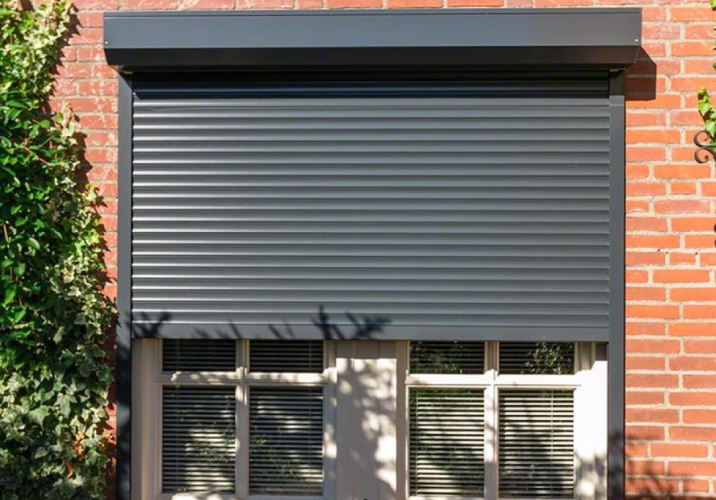Roller shutters are a straightforward kind of machinery. A roller shutter is simply a vertical shield, mounted above a door or window, which can roll down to cover the vulnerable point of entry.
Typically made from horizontal metal slats, they roll up and down within guides fitted on both sides. They’re commonly used as a form of security to prevent intruders from gaining access.
Their main purpose may be to provide protection, but there are many additional benefits of roller shutters, such as reduced noise pollution and savings on energy bills due to their insulation.
From roller shutters in Liverpool to roller shutters in Bolton, you’re bound to see these security features on a variety of commercial, industrial, and domestic buildings.
Let’s take a closer look at the different types of roller shutters out there, and how their individual parts work to keep the roller shutter doors in service.
Types of roller shutter systems
There are many different kinds of roller shutters to choose from, but the two most common types are manual roller shutters and motorized roller shutters (also known as electrical roller shutters).
Manually operated roller shutters require pushing up to open and pulling down to close, either by hand or using a pull handle or winding handle. These can take considerable elbow grease to operate, and you have to take extra care not to slam the shutter against the ground or top frame.
For those with a bigger budget who prefer the modern convenience of a motorized system, electrical shutters allow you to open or close them with the press of a button. Some even have a remote or key switch, so you can raise or lower the shutters from the comfort of your vehicle.
In case of power failures or other such emergencies, even motorized roller shutters will have a manual system as a backup, such as a winding handle or pull chain. This gives you the best of both worlds, making electrical roller shutters the most popular choice by far.
It’s common to see roller shutters on shop fronts, restaurants, offices, warehouses, loading bays, and residential garages. They can be manufactured to a bespoke design according to individual height and width, thermal and safety features, and aesthetic finish requirements.
Roller shutter door components
Roller shutters are made up of interconnected slats which slide up and down through tracks on either side of the door or window they’re covering. This structure allows the slats to roll up into a coil when the shutter is opened, stored within a small box above the door or window.
This box is usually installed inside, known as an ‘internal face fix’ – this is more secure than installing the box externally. The shutters are carefully designed to fit snugly and securely on all sides when rolled down, utilising a variety of parts that work together in the following ways:
Curtain
The curtain is the main part of the shutter, made from interlocking lengths of fabricated metal called ‘laths’ – these are held together at the ends and supported with horizontal rods.
Bottom rail
As the final section at the bottom of the curtain, this slat usually has a ‘T’ or ‘L’ shape to give it extra rigidity, supporting the curtain and preventing damage where it meets the ground.
Roller assembly
A full-width roller holds the shutter curtain in place and winds it up when opened, supported by cheek plates – this steel tube will house a motor if the shutter is electrically powered.
Guide channels
There are two hollow channels, known as aspect guides, which are U-shaped vertical sections on either side that provide a pathway for the shutter curtain to run up and down.
Cheek plate
Also known as finish plates or end plates, load-bearing cheek plates are secured to the building on either side to take the weight of the shutter and hold the rollers in place.
Flag post
Flag posts support the cheek plates, which are welded at an angle or directly above the guides. They’re also attached to the building and aid in the installation of the roller shutter.
Tubular motor
A hollow motor housed in the overhead barrel assembly will control the mechanical operations of the shutter, with limit switches and a manual override for greater control.
Safety brake
If the motor fails and cannot hold the shutter open, or the curtain descends much too fast, this will activate a centrifugal brake that should halt the shutter in its descent.
U-Cup or bearing
If the shutter doesn’t have a safety brake, a U-shaped bearing can be fitted to the cheek plates to support the barrel and help to maintain the roller movement.
Canopy
This hood, cowl, or enclosure is an extra cover that protects the barrel, curtain, and cheek plates from dirt, rain, or other blockages. It’s only compulsory if the shutter is less than 2.5m high.
Finish
Most shutters are made using durable metals like aluminum or galvanized steel, with powder coating finishes available to add a custom color and enhance the aesthetic.
Lock
Any door is only as secure as its weakest point, so a shutter should be locked in place at the bottom when closed. This could be a specially fitted bullet lock, rail lock, or ground lock.
How often do roller shutters need servicing?
Careful operation and regular maintenance are necessary to keep roller shutters working smoothly. Problems such as slow and juddery movement, partial opening and closing, or failure to operate at all can cause further issues for businesses and homeowners alike.
It’s best to avoid potential disruptions by having an inspection at least once a year, which is also a legal requirement under the Health and Safety Act. This involves a professional checking that every component is working properly and arranging repairs for any faults.
Whether you need roller shutter repairs in Lancashire, such as roller shutter repairs in Manchester, or elsewhere in the UK, it’s best to hire an expert for professional roller shutter servicing. This includes resetting or replacing safety brakes after emergency activation.












